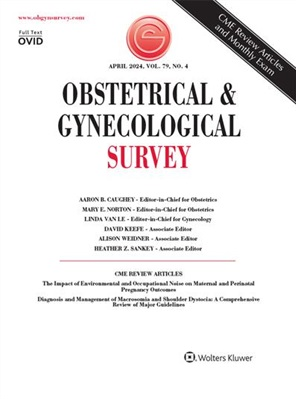妊娠期使用低剂量阿司匹林和早产风险:瑞典基于登记的队列研究
IF 4.3
4区 医学
Q1 OBSTETRICS & GYNECOLOGY
引用次数: 0
摘要
有证据表明,低剂量阿司匹林可以降低具有危险因素的妇女发生子痫前期的风险;最近的证据表明,阿司匹林对预防自发性早产也很有用,即使对没有子痫前期危险因素的妇女也是如此。然而,检验低剂量阿司匹林在这一人群中的有效性的研究较少,而且已经完成的研究通常在统计上不足。本研究旨在解决这一局限性,在大量曾经历过早产的妇女中,评估低剂量阿司匹林治疗是否与较低的早产风险相关。本研究是一项基于登记的队列研究,使用了几个不同的瑞典登记中心。样本包括2006年至2019年期间第一次和第二次单胎分娩以及第一次怀孕早产的所有女性。评估的主要结局是第二次妊娠期间的早产,次要结局包括根据严重程度(中度早产在妊娠32至36周之间,严重早产在妊娠32周以下)和发病(自然或医学指征)来评估早产。感兴趣的变量是低剂量阿司匹林暴露或至少一次75至160毫克阿司匹林的配发处方。该研究分析了22127名第一次怀孕时早产、第二次怀孕的女性。在该样本中,3057名(14%)在第二次怀孕期间服用了低剂量阿司匹林。3703例发生复发性早产,其中547例(15%)使用过低剂量阿司匹林。在调整混杂变量后,使用低剂量阿司匹林的早产儿发生率较低,边际相对风险(mRR)为0.87(95%可信区间[CI], 0.77-0.99)。然而,中度或重度早产的风险没有差异(中度组:mRR, 0.90 [95% CI, 0.78-1.03];重症组:mRR为0.75 [95% CI, 0.54-1.04])。在调整后的分析中,使用低剂量阿司匹林和不使用阿司匹林的个体在医学指征或自发性早产方面没有统计学上的显著差异。这项研究的局限性在于它是回顾性的。此外,作者承认,阿司匹林的配发处方并不一定等同于在整个怀孕期间持续摄入低剂量阿司匹林。此外,这项研究的人群仅限于那些已经经历过早产的人,这可能会影响结果的普遍性。虽然发现了有限的差异,但不能排除有小的保护作用,更全面地了解低剂量阿司匹林对早产的影响的随机对照试验将有所帮助。进一步的研究还应该关注怀孕期间服用阿司匹林的益处是否大于潜在的风险,以及最低有效剂量可能是多少。本文章由计算机程序翻译,如有差异,请以英文原文为准。
Low-Dose Aspirin Use in Pregnancy and the Risk of Preterm Birth: A Swedish Register-Based Cohort Study
ABSTRACT Evidence has shown that low-dose aspirin can reduce the risk of preeclampsia in women with risk factors; more recent evidence has shown that aspirin may also be useful for the prevention of spontaneous preterm birth, even among women without risk factors for preeclampsia. However, there are fewer studies examining the effectiveness of low-dose aspirin in this population, and the studies that have been done have generally been statistically underpowered. This study was meant to address this limitation in a large population of women who had previously experienced preterm birth, assessing whether low-dose aspirin treatment was associated with a lower risk for preterm birth. This study was a register-based cohort study performed using several different Swedish registries. The sample included all women with a first and second singleton birth between 2006 and 2019 and with a preterm birth in the first pregnancy. The primary outcome assessed was preterm birth during the second pregnancy, and secondary outcomes included assessment of preterm birth by severity (moderate preterm was between 32 and 36 weeks' gestation, and severe preterm was less than 32 weeks' gestation) and onset (spontaneous or medically indicated). The variable of interest was low-dose aspirin exposure or at least 1 dispensed prescription of 75 to 160 mg aspirin. The analysis included 22,127 women with a preterm birth in their first pregnancy followed by a second recorded pregnancy. Of this sample, 3057 (14%) were prescribed low-dose aspirin during their second pregnancy. Recurrent preterm birth occurred in 3703 individuals, of whom 547 (15%) had used low-dose aspirin. After adjusting for confounding variables, the incidence of preterm birth was lower in those using low-dose aspirin, with a marginal relative risk (mRR) of 0.87 (95% confidence interval [CI], 0.77–0.99). However, there was no difference in risk for moderate or severe preterm birth (moderate group: mRR, 0.90 [95% CI, 0.78–1.03]; severe group: mRR, 0.75 [95% CI, 0.54–1.04]). In adjusted analyses, there were no statistically significant differences for either medically indicated or spontaneous preterm birth between individuals who used low-dose aspirin and those who did not. The study was limited by its retrospective nature. In addition, the authors acknowledge that a dispensed prescription for aspirin does not necessarily equate to consistent intake of low-dose aspirin throughout a pregnancy. In addition, the population for this study was limited to those who had already experienced a preterm birth, which could affect the generalizability of the results. Although limited differences were found, a small protective effect could not be ruled out, and randomized controlled trials to understand more fully the effect low-dose aspirin might have on preterm birth would be helpful. Further research should also focus on whether the benefits of aspirin use during pregnancy outweigh the potential risks, as well as what the lowest effective dose might be.
求助全文
通过发布文献求助,成功后即可免费获取论文全文。
去求助
来源期刊
CiteScore
2.70
自引率
3.20%
发文量
245
审稿时长
>12 weeks
期刊介绍:
Each monthly issue of Obstetrical & Gynecological Survey presents summaries of the most timely and clinically relevant research being published worldwide. These concise, easy-to-read summaries provide expert insight into how to apply the latest research to patient care. The accompanying editorial commentary puts the studies into perspective and supplies authoritative guidance. The result is a valuable, time-saving resource for busy clinicians.

 求助内容:
求助内容: 应助结果提醒方式:
应助结果提醒方式:


